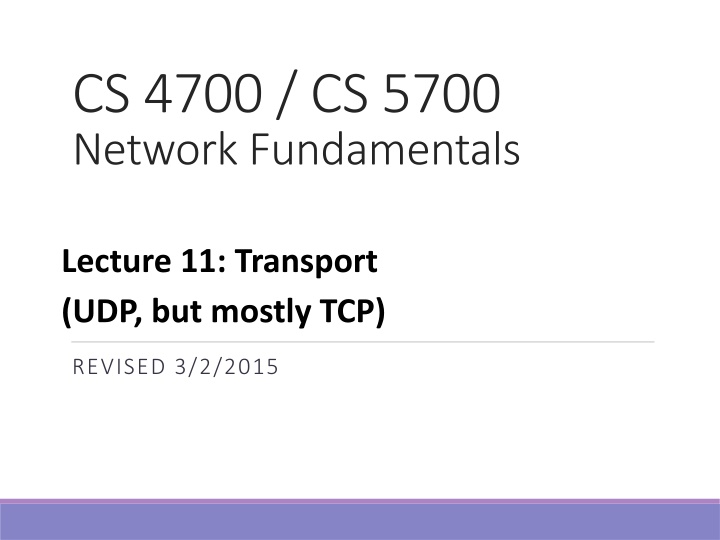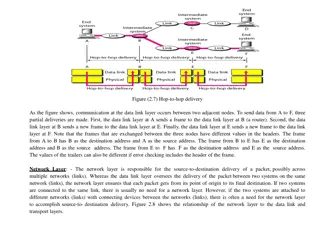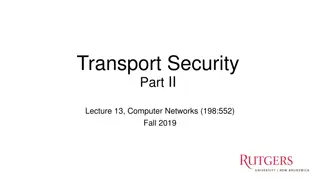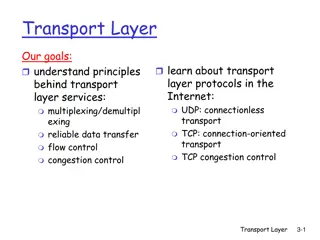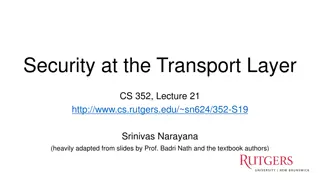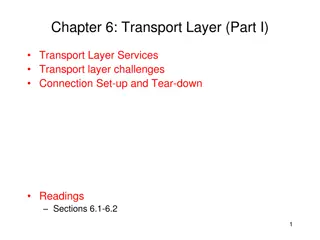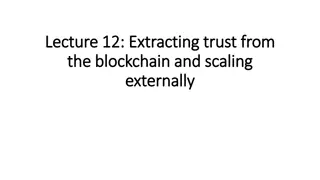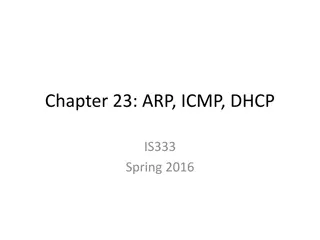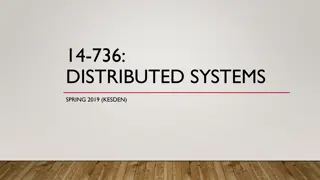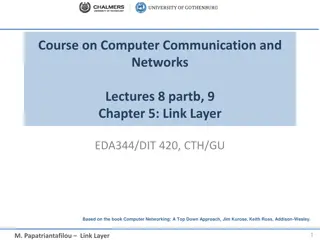Network Fundamentals: Transport Layer Overview
This content delves into the functions and challenges of the transport layer, focusing on demultiplexing data streams, reliability in packet delivery, congestion control, and more. It explores UDP and TCP protocols, evolution of TCP, multiplexing, demultiplexing, and the User Datagram Protocol (UDP). The information covers how servers communicate with multiple clients, the importance of layering in networking, and the characteristics of UDP as a connectionless datagram protocol.
Download Presentation

Please find below an Image/Link to download the presentation.
The content on the website is provided AS IS for your information and personal use only. It may not be sold, licensed, or shared on other websites without obtaining consent from the author.If you encounter any issues during the download, it is possible that the publisher has removed the file from their server.
You are allowed to download the files provided on this website for personal or commercial use, subject to the condition that they are used lawfully. All files are the property of their respective owners.
The content on the website is provided AS IS for your information and personal use only. It may not be sold, licensed, or shared on other websites without obtaining consent from the author.
E N D
Presentation Transcript
CS 4700 / CS 5700 Network Fundamentals Lecture 11: Transport (UDP, but mostly TCP) REVISED 3/2/2015
Transport Layer Function: Demultiplexing of data streams Application Presentation Optional functions: Creating long lived connections Reliable, in-order packet delivery Error detection Flow and congestion control Session Transport Network Data Link Physical Key challenges: Detecting and responding to congestion Balancing fairness against high utilization 2
Outline UDP TCP CONGESTION CONTROL EVOLUTION OF TCP PROBLEMS WITH TCP 3
The Case for Multiplexing Datagram network No circuits No connections Clients run many applications at the same time Who to deliver packets to? Transport Network Data Link Physical IP header protocol field 8 bits = 256 concurrent streams Insert Transport Layer to handle demultiplexing Packet 4
Demultiplexing Traffic Server applications communicate with multiple clients Endpoints identified by <src_ip, src_port, dest_ip, dest_port> Host 1 Host 2 Unique port for each application Applications share the same network Host 3 Application Transport P1 P2 P3 P4 P5 P6 P7 Network 5
Layering, Revisited Layers communicate peer-to-peer Host 1 Host 2 Router Application Application Transport Transport Network Network Network Data Link Data Link Data Link Physical Physical Physical Lowest level end-to-end protocol (in theory) Transport header only read by source and destination Routers view transport header as payload 6
User Datagram Protocol (UDP) 0 16 31 Destination Port Checksum Source Port Payload Length Simple, connectionless datagram C sockets: SOCK_DGRAM Port numbers enable demultiplexing 16 bits = 65535 possible ports Port 0 is invalid Checksum for error detection Detects (some) corrupt packets Does not detect dropped, duplicated, or reordered packets 7
Uses for UDP Invented after TCP Why? Not all applications can tolerate TCP Custom protocols can be built on top of UDP Reliability? Strict ordering? Flow control? Congestion control? Examples RTMP, real-time media streaming (e.g. voice, video) Facebook datacenter protocol 8
Outline UDP TCP CONGESTION CONTROL EVOLUTION OF TCP PROBLEMS WITH TCP 9
Transmission Control Protocol Reliable, in-order, bi-directional byte streams Port numbers for demultiplexing Virtual circuits (connections) Flow control Congestion control, approximate fairness Why these features? 0 4 16 31 Source Port Destination Port Sequence Number Acknowledgement Number Flags Checksum HLen Advertised Window Urgent Pointer Options 10
Connection Setup Why do we need connection setup? To establish state on both hosts Most important state: sequence numbers Count the number of bytes that have been sent Initial value chosen at random Why? Important TCP flags (1 bit each) SYN synchronization, used for connection setup ACK acknowledge received data FIN finish, used to tear down connection 11
Three Way Handshake Client Server Why Sequence # +1? Each side: Notifies the other of starting sequence number ACKs the other side s starting sequence number 12
Connection Setup Issues Connection confusion How to disambiguate connections from the same host? Random sequence numbers Source spoofing Kevin Mitnick Need good random number generators! Connection state management Each SYN allocates state on the server SYN flood = denial of service attack Solution: SYN cookies 13
Connection Tear Down Either side can initiate tear down Client Server Other side may continue sending data Half open connection shutdown() Acknowledge the last FIN Sequence number + 1 14
Sequence Number Space TCP uses a byte stream abstraction Each byte in each stream is numbered 32-bit value, wraps around Initial, random values selected during setup Byte stream broken down into segments (packets) Size limited by the Maximum Segment Size (MSS) Set to limit fragmentation Each segment has a sequence number 13450 14950 16050 17550 Segment 8 Segment 9 Segment 10 15
Bidirectional Communication Client Server Seq. 1 Ack. 23 Seq. 23 Ack. 1 23 1461 1461 753 Data and ACK in the same packet 753 2921 Each side of the connection can send and receive Different sequence numbers for each direction 16
Flow Control Problem: how many packets should a sender transmit? Too many packets may overwhelm the receiver Size of the receivers buffers may change over time Solution: sliding window Receiver tells the sender how big their buffer is Called the advertised window For window size n, sender may transmit n bytes without receiving an ACK After each ACK, the window slides forward Window may go to zero! 17
Flow Control: Sender Side Packet Received Packet Sent Src. Port Dest. Port Src. Port Dest. Port Sequence Number Sequence Number Acknowledgement Number Acknowledgement Number HL Window HL Flags Flags Window Urgent Pointer Urgent Pointer Checksum Checksum Must be buffered until ACKed App Write ACKed Sent To Be Sent Outside Window Window 18
Sliding Window Example TCP is ACK Clocked Short RTT quick ACK window slides quickly Long RTT slow ACK window slides slowly Time Time 19
What Should the Receiver ACK? 1. ACK every packet 2. Use cumulative ACK, where an ACK for sequence n implies ACKS for all k < n 3. Use negative ACKs (NACKs), indicating which packet did not arrive 4. Use selective ACKs (SACKs), indicating those that did arrive, even if not in order SACK is an actual TCP extension 20 20
Sequence Numbers, Revisited 32 bits, unsigned Why so big? For the sliding window you need |Sequence # Space| > 2 * |Sending Window Size| 232 > 2 * 216 Guard against stray packets IP packets have a maximum segment lifetime (MSL) of 120 seconds i.e. a packet can linger in the network for 3 minutes Sequence number would wrap around at 286Mbps What about GigE? PAWS algorithm + TCP options 21
Silly Window Syndrome Problem: what if the window size is very small? Multiple, small packets, headers dominate data Header Header Header Header Data Data Data Data Equivalent problem: sender transmits packets one byte at a time 1. for (int x = 0; x < strlen(data); ++x) 2. write(socket, data + x, 1); 22
Nagles Algorithm 1. If the window >= MSS and available data >= MSS: Send the data Send a full packet 2. Elif there is unACKed data: Enqueue data in a buffer (send after a timeout) 3. Else: send the data Send a non-full packet if nothing else is happening Problem: Nagle s Algorithm delays transmissions What if you need to send a packet immediately? 1. int flag = 1; 2. setsockopt(sock, IPPROTO_TCP, TCP_NODELAY, (char *) &flag, sizeof(int)); 23
Error Detection Checksum detects (some) packet corruption Computed over IP header, TCP header, and data Sequence numbers catch sequence problems Duplicates are ignored Out-of-order packets are reordered or dropped Missing sequence numbers indicate lost packets Lost segments detected by sender Use timeout to detect missing ACKs Need to estimate RTT to calibrate the timeout Sender must keep copies of all data until ACK 24
Retransmission Time Outs (RTO) Problem: time-out is linked to round trip time Timeout is too short RTO RTO What about if timeout is too long? 25
Round Trip Time Estimation Sample Original TCP round-trip estimator RTT estimated as a moving average new_rtt = (old_rtt) + (1 )(new_sample) Recommended : 0.8-0.9 (0.875 for most TCPs) RTO = 2 * new_rtt (i.e. TCP is conservative) Today: RTO = new_rtt + 4*DevRTT 26
RTT Sample Ambiguity RTO RTO Sample? Sample Karn s algorithm: ignore samples for retransmitted segments 27
Outline UDP TCP CONGESTION CONTROL EVOLUTION OF TCP PROBLEMS WITH TCP 28
What is Congestion? Load on the network is higher than capacity Capacity is not uniform across networks Modem vs. Cellular vs. Cable vs. Fiber Optics There are multiple flows competing for bandwidth Residential cable modem vs. corporate datacenter Load is not uniform over time 10pm, Sunday night = Bittorrent Game of Thrones 29
Why is Congestion Bad? Results in packet loss Routers have finite buffers Internet traffic is self similar, no buffer can prevent all drops When routers get overloaded, packets will be dropped Practical consequences Router queues build up, delay increases Wasted bandwidth from retransmissions Low network goodput 30
The Danger of Increasing Load Congestion Collapse Knee point after which Throughput increases very slow Delay increases fast Knee Cliff Goodput In an M/M/1 queue Delay = 1/(1 utilization) Ideal point Cliff point after which Throughput 0 Delay Load Delay Load 31
Cong. Control vs. Cong. Avoidance Congestion Control: Stay left of the cliff Congestion Avoidance: Stay left of the knee Knee Cliff Goodput Congestion Collapse Load 32
Advertised Window, Revisited Does TCP s advertised window solve congestion? NO The advertised window only protects the receiver A sufficiently fast receiver can max the window What if the network is slower than the receiver? What if there are other concurrent flows? Key points Window size determines send rate Window must be adjusted to prevent congestion collapse 33
Goals of Congestion Control 1. Adjusting to the bottleneck bandwidth 2. Adjusting to variations in bandwidth 3. Sharing bandwidth between flows 4. Maximizing throughput 34
General Approaches Do nothing, send packets indiscriminately Many packets will drop, totally unpredictable performance May lead to congestion collapse Reservations Pre-arrange bandwidth allocations for flows Requires negotiation before sending packets Must be supported by the network Dynamic adjustment Use probes to estimate level of congestion Speed up when congestion is low Slow down when congestion increases Messy dynamics, requires distributed coordination 35
TCP Congestion Control Each TCP connection has a window Controls the number of unACKed packets Sending rate is ~ window/RTT Idea: vary the window size to control the send rate Introduce a congestion window at the sender Congestion control is sender-side problem 36
Congestion Window (cwnd) Limits how much data is in transit Denominated in bytes 1. wnd = min(cwnd, adv_wnd); 2. effective_wnd = wnd (last_byte_sent last_byte_acked); last_byte_sent last_byte_acked effective_wnd wnd 37
Two Basic Components 1. Detect congestion Packet dropping is most reliable signal Delay-based methods are hard and risky How do you detect packet drops? ACKs Timeout after not receiving an ACK Several duplicate ACKs in a row (ignore for now) Except on wireless networks 2. Rate adjustment algorithm Modify cwnd Probe for bandwidth Responding to congestion 38
Rate Adjustment Recall: TCP is ACK clocked Congestion = delay = long wait between ACKs No congestion = low delay = ACKs arrive quickly Basic algorithm Upon receipt of ACK: increase cwnd Data was delivered, perhaps we can send faster cwnd growth is proportional to RTT On loss: decrease cwnd Data is being lost, there must be congestion Question: increase/decrease functions to use? 39
Utilization and Fairness Max More than full utilization (congestion) Ideal point Max efficiency Perfect fairness Equal throughput (fairness) throughput for flow 2 Less than full utilization Flow 2 Throughput Zero Zero throughput for flow 1 for flow 2 throughput Max throughput for flow 1 Flow 1 Throughput 40
Multiplicative Increase, Additive Decrease Not stable! Veers away from fairness Flow 2 Throughput Flow 1 Throughput 41
Additive Increase, Additive Decrease Stable But does not converge to fairness Flow 2 Throughput Flow 1 Throughput 42
Multiplicative Increase, Multiplicative Decrease Stable But does not converge to fairness Flow 2 Throughput Flow 1 Throughput 43
Additive Increase, Multiplicative Decrease Converges to stable and fair cycle Symmetric around y=x Flow 2 Throughput Flow 1 Throughput 44
Implementing Congestion Control Maintains three variables: cwnd: congestion window adv_wnd: receiver advertised window ssthresh: threshold size (used to update cwnd) For sending, use: wnd = min(cwnd, adv_wnd) Two phases of congestion control 1. Slow start (cwnd < ssthresh) Probe for bottleneck bandwidth 2. Congestion avoidance (cwnd >= ssthresh) AIMD 45 45
Slow Start Goal: reach knee quickly Knee Cliff Upon starting/restarting a connection cwnd =1 ssthresh = adv_wnd Each time a segment is ACKed, cwnd++ Goodput Load Continues until ssthresh is reached Or a packet is lost Slow Start is not actually slow cwnd increases exponentially 46
Slow Start Example cwnd = 1 cwnd grows rapidly Slows down when cwnd >= ssthresh cwnd = 2 Or a packet drops cwnd = 4 cwnd = 8 47
Congestion Avoidance AIMD mode ssthresh is lower-bound guess about location of the knee Ifcwnd >= ssthresh then each time a segment is ACKed increment cwnd by 1/cwnd (cwnd += 1/cwnd). So cwnd is increased by one only if all segments have been acknowledged 48
Congestion Avoidance Example cwnd = 1 cwnd = 2 cwnd >= ssthresh 14 cwnd (in segments) cwnd = 4 12 10 ssthresh = 8 8 6 cwnd = 8 Slow Start 4 2 0 t=0 t=2 Round Trip Times t=4 t=6 cwnd = 9 49
TCP Pseudocode Initially: cwnd = 1; ssthresh = adv_wnd; New ack received: if (cwnd < ssthresh) /* Slow Start*/ cwnd = cwnd + 1; else /* Congestion Avoidance */ cwnd = cwnd + 1/cwnd; Timeout: /* Multiplicative decrease */ ssthresh = cwnd/2; cwnd = 1; 50
